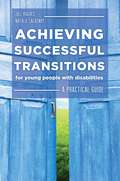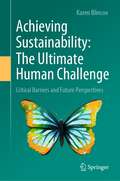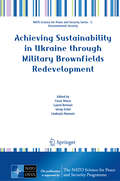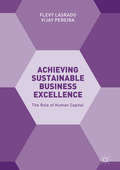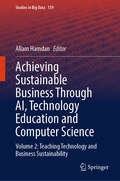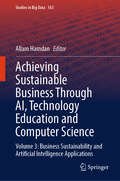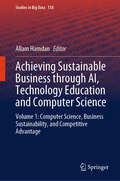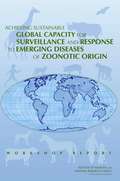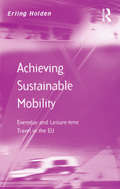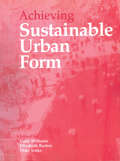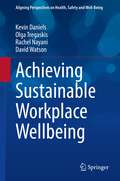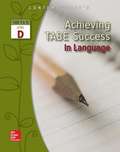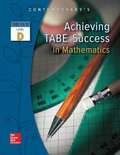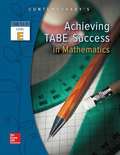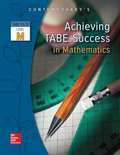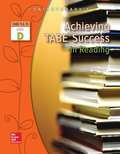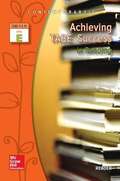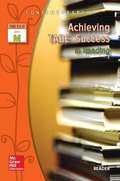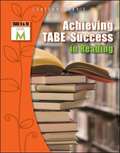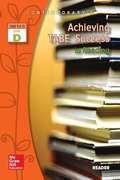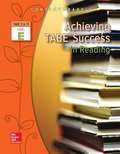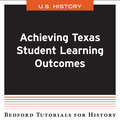- Table View
- List View
Achieving Successful Transitions for Young People with Disabilities: A Practical Guide
by Natalie Lackenby Jill Hughes Jonathan MonkThis best practice guide provides a blueprint for managing seamless transitions between services for young people aged 16-25 with additional needs, including learning disabilities, physical disabilities, complex health needs and sensory impairments. The authors cover a wide range of transitions, including moving from children's to adult's services, from school to college, leaving education and gaining work experience and employment and supporting young people to live independently. They include key information on policy and legislation, the statutory duty of local authorities and health, housing and education agencies, and describe the impact of the new Education, Health and Care (EHC) Plans. With a wealth of practical, common sense guidance for navigating this complex area of work in a timely, efficient and cost-effective manner, the book will guide practitioners and students step-by-step through the process of managing transitions, highlighting best practice and providing evidence-based models to ensure the best possible outcomes for service users and their families. An essential resource for all those involved in supporting young people with additional needs through transitions, including social workers and social work students, occupational therapists, speech and language therapists, health professionals and special education teachers.
Achieving Supply Chain Agility: Information System Integration in the Chinese Automotive Industry
by Yi WuThis book identifies factors of information system (IS) integration that influence supply chain agility and illustrates how IS integration can achieve greater supply chain agility. Also considering the consequent operational impacts that arise from IS-enabled supply chain agility, the author presents real-life examples through interviews and surveys to explore how IS integrations affect supply chain agility in the context of the Chinese automotive industry. The ability to swiftly respond to competitive challenges is a key element in industry 4.0 and organisations with agile supply chains are better prepared to respond to uncertainties and changes. This book develops and presents guidelines on the deployment of information system integration in order to achieve efficient agile supply chains.
Achieving Sustainability: Critical Barriers and Future Perspectives
by Karen BlincoeThe book provides an assessment of whether sustainability is realizable in the current societal framework. What are the challenges and the barriers - and what are the levers necessary to meet and overcome them?Through a revision of the essence of sustainability the book provides an opportunity to understand the deeper level of the radical change that sustainability represents, and the resistance that is preventing its realization.To build the argument the sustainable development model is compared with current development theories as well as alternative solutions based on utopian models of the past. The book assesses the results that can be achieved within the current systemic framework, based on case stories. It outlines the limitations to sustainability, pointing out and defining the multiple, cross-sectoral and systemic barriers that hinder the transition.Finally, the book offers perspectives on achieving a sustainable future, encompassing the impacts from recent events including the pandemic as well as the multiple mitigation and transition initiatives undertaken globally.Brian Goodwin's QuoteLike the caterpillar that wraps itself up in its silken swaddling bands prior to its metamorphosis into a butterfly, we have wrapped ourselves in a tangled skin from which we can emerge only by going through a similarly dramatic transformation.
Achieving Sustainability in Ukraine through Military Brownfields Redevelopment (NATO Science for Peace and Security Series C: Environmental Security)
by Cezar Morar Laurel Berman Serap Erdal Liudmyla NiemetsThis book is written by international experts who are brownfields practitioners from over 15 countries. Blighted and contaminated properties, including military, industrial, commercial, and multi-residential properties, globally referred to as “brownfields,” are a shared phenomenon among NATO and NATO-partner countries. They provide practical solutions to addressing, evaluating, and cleaning up brownfields, including multiple case studies. Topics include reuse of military brownfields, sustainable site reuse, community engagement, risk assessment, impacts of the war in Ukraine related to military brownfields development and redevelopment, a free training to improve capacity to evaluate environmental and health risks of brownfields, and shared best practices.
Achieving Sustainable Business Excellence: The Role Of Human Capital
by Vijay Pereira Flevy LasradoCompiling the best practices of business excellence frameworks around the world, this new book addresses the need for innovative research on sustainable business performance. Using detailed empirical studies, the authors outline the motives and benefits of the implementation of such frameworks in different geographical regions. Comprehensive case studies showcase how the variety of excellence frameworks are manifested in their work cultures, values and beliefs. Academics studying quality management, HRM, and international business will find this book an essential read as it establishes the relevance of human capital in achieving and sustaining global business excellence.
Achieving Sustainable Business Through AI, Technology Education and Computer Science: Volume 2: Teaching Technology and Business Sustainability (Studies in Big Data #159)
by Allam HamdanThis book delves into the relationship between artificial intelligence, technology education, and computer science intersect with sustainable business practices. This book discovers the transformative potential of cutting-edge technologies like artificial intelligence, machine learning, and blockchain across diverse sectors such as health care, education, government services, and digital transformation.
Achieving Sustainable Business Through AI, Technology Education and Computer Science: Volume 3: Business Sustainability and Artificial Intelligence Applications (Studies in Big Data #163)
by Allam HamdanThis book focuses on the symbiotic relationship between sustainable practices and cutting-edge AI technologies, offering insights into how businesses can thrive in a rapidly evolving landscape. This book discovers how AI is revolutionizing sustainability efforts, driving efficiency, and fostering a greener tomorrow. From smart energy management to ethical supply chain practices, this book is a guide for organizations looking to harness the power of AI for a sustainable future. Engaging, informative, and forward-thinking, this book is essential reading for leaders shaping the future of business.
Achieving Sustainable Business through AI, Technology Education and Computer Science: Volume 1: Computer Science, Business Sustainability, and Competitive Advantage (Studies in Big Data #158)
by Allam HamdanThis book aims to explore the intersection of AI, technology education, and computer science with sustainable business practices. It delves into the application of cutting-edge technologies such as artificial intelligence, machine learning, and blockchain in various business domains, including healthcare, education, government services, and digital transformation.
Achieving Sustainable E-Government in Pacific Island States (Public Administration and Information Technology #27)
by Rowena Cullen Graham HassallThis book analyzes the common set of obstacles to the development and integration of government Information and Communication Technology (ICT) projects and effective e-government initiatives in developing countries. It draws on the expertise and experience of more developed states in the Pacific, notably Australia and New Zealand, both highly rated in global rankings for e-government and active in a variety of e-government development projects across the region. There has been a general failure to identify priorities and align projects with local needs in ICT/e-government projects. Small Island Developing States (or SIDS) present a unique problem in terms of e-government. Not only do they suffer from a common set of barriers to ICT development such as their remoteness, geographical dispersion, moist tropical climates, largely rural populations, and lack of ICT capacity and infrastructure, but are also dependent on external agencies for investment, and must negotiate with powerful donors who have conflicting agendas. E-government is widely regarded as 'transformational', increasing efficiency, productivity, accountability, economic growth, and citizen involvement. But while the governments of SIDS are committed to harnessing ICTs for effective government and economic development, they face major challenges in establishing successful e-government initiatives, due to the problems outlined above, coupled with a lack of HR capacities and appropriate strategies and policies. Drawing on the experience of the states mentioned above, as well as regional quasi-governmental bodies, nongovernmental organizations (NGOs), aid agencies, and the private sector, the book will be of interest to researchers and students in the fields of e-government, public administration, political science, communication, information science, and social media.
Achieving Sustainable Global Capacity For Surveillance And Response To Emerging Diseases Of Zoonotic Origin: Workshop Report
by Institute of Medicine National Research Council of the National AcademiesOne of the biggest threats today is the uncertainty surrounding the emergence of a novel pathogen or the re-emergence of a known infectious disease that might result in disease outbreaks with great losses of human life and immense global economic consequences. Over the past six decades, most of the emerging infectious disease events in humans have been caused by zoonotic pathogens--those infectious agents that are transmitted from animals to humans. In June 2008, the Institute of Medicine's and National Research Council's Committee on Achieving Sustainable Global Capacity for Surveillance and Response to Emerging Diseases of Zoonotic Origin convened a workshop. This workshop addressed the reasons for the transmission of zoonotic disease and explored the current global capacity for zoonotic disease surveillance.
Achieving Sustainable Mobility: Everyday and Leisure-time Travel in the EU (Transport and Mobility)
by Erling HoldenSustainable mobility has become the new imperative for transport policy. There have been a number of policy attempts at sustainable mobility globally, such as the development of more efficient conventional transport technologies, the promotion of efficient and affordable public transport systems and the encouragement of environmental awareness. Such policies have so often been presented as prerequisites for sustainable mobility that they are now taken for granted. But are any of these policies really successful? To what extent do they actually contribute (or fail to contribute) to sustainable mobility? Why do some policies succeed and others fail? Using an interdisciplinary approach which brings together various theories and methodologies, this book tests each of these policies - or hypotheses, as the author sees them - with detailed empirical investigations. It also argues that leisure-time travel should be included in any sustainable mobility policies, as it now accounts for 50 per cent of all annual travel distance in developed countries. The book concludes by suggesting fourteen theses of sustainable mobility for the EU and a new model for future best practice.
Achieving Sustainable Urban Form
by Katie Williams Elizabeth Burton Mike JenksAchieving Sustainable Urban Form represents a major advance in the sustainable development debate. It presents research which defines elements of sustainable urban form - density, size, configuration, detailed design and quality - from macro to micro scale. Case studies from Europe, the USA and Australia are used to illustrate good practice within the fields of planning, urban design and architecture.
Achieving Sustainable Workplace Wellbeing (Aligning Perspectives On Health, Safety And Well-being Ser.)
by Kevin Daniels Olga Tregaskis Rachel Nayani David WatsonIn this groundbreaking interdisciplinary work, the authors focus on organizational analysis to understand workplace wellbeing, deviating from previous research that mostly looks at the individual worker or intervention. In addressing the question of why workplace health and wellbeing practices initiatives fall short of delivering sustained improvements in worker wellbeing, this book moves beyond localized explanations of the failure of specific interventions. Instead, it creates theoretical frameworks that explain how wellbeing at work can be improved and sustained. The authors use evidence from systematic and comprehensive surveys of the literature as well as new empirical research, and present an explanatory framework of the processes through which organizations change to implement and accommodate workplace health and wellbeing practices. Learning, adaptation and continuation explain successful implementation of workplace health and wellbeing practices, while Gestalting, fracturing and grafting explain how organizations resolve or negotiate conflict between health and wellbeing practices and existing organizational procedures, systems and practices. In addition, the authors reflect on the implications for research of reframing the unit of analysis as the organization and how studies on workplace wellbeing practices can provide a conceptual platform for thinking about the way organizations can create social value in a broader sense. This book, authored by experts in their field, is a great resource for academics and professionals of organizational studies and of worker wellbeing across the social sciences, behavioural sciences, business and management courses, wellbeing research, and labour studies.
Achieving TABE Success In Language: Level D
by Linda Kwil Sean Klumder Genevieve Kelley Vickie TrippTo the Learner: If you have had problems expressing your ideas, particularly in writing, Contemporary's Achieving TABE® Success in Language will help. The workbook will explain basic grammar and composition skills and let you practice those skills in focused exercises. Achieving TABE® Success in Language will increase your confidence in your ability to communicate both orally and in writing. Achieving TABE® Success in Language will help you develop specific language skills, especially writing skills. The workbook is self-contained with the Answer Key at the back of the book. Clear directions will guide you through the lessons and exercises.
Achieving TABE Success In Mathematics Level D
by Contemporary McGraw-Hill Education StaffThe Achieving TABE Success family is designed to provide complete skill preparation and practice for TABE 9&10, encompassing Reading, Mathematics and Language, for levels E, M, D and A. This series of books will help students achieve NRA gain through targeted instruction that specifically addresses TABE 9&10 skills. Achieving TABE Success . . . workbooks contain the following features: TABE 9&10 Correlation Charts Each text contains a TABE 9&10 Correlation Chart that links each question to targeted skill lessons, enabling instructors and students to build a personalized study plan based on skill level strengths and weaknesses. Pre-tests and Post-tests Each workbook begins with a pre-test and a skills correlation chart to help diagnose strengths and weaknesses and determine TABE readiness. The format of each pre- and post-test matches that of the actual TABE test. Targeted TABE Skill Lessons Each lesson specifically targets a TABE skill. Students work with the innovative lesson format that provides step-by-step instruction to help insure success. The Mathematics lessons offer plenty of instruction and practice to help master each TABE skill. Unit Reviews and Math Glossary Unit reviews are divided into two parts: Review, which summarizes unit content, and Assessment, to determine student understanding. Mathematics texts contain a Glossary of Common Terms to help students with the language of math. Text/TABE Level Content Level Level E 2. 0 - 3. 9 Level M 4. 0 - 5. 9 Level D 6. 0 - 8. 9 Level A 9. 0 - 12. 9
Achieving Tabe Success In Mathematics Level E
by Contemporary McGraw-Hill Education StaffThe Achieving TABE Success family is designed to provide complete skill preparation and practice for TABE 9&10, encompassing Reading, Mathematics and Language, for levels E, M, D and A. This series of books will help students achieve NRA gain through targeted instruction that specifically addresses TABE 9&10 skills. Achieving TABE Success . . . workbooks contain the following features: TABE 9&10 Correlation Charts Each text contains a TABE 9&10 Correlation Chart that links each question to targeted skill lessons, enabling instructors and students to build a personalized study plan based on skill level strengths and weaknesses. Pre-tests and Post-tests Each workbook begins with a pre-test and a skills correlation chart to help diagnose strengths and weaknesses and determine TABE readiness. The format of each pre- and post-test matches that of the actual TABE test. Targeted TABE Skill Lessons Each lesson specifically targets a TABE skill. Students work with the innovative lesson format that provides step-by-step instruction to help insure success. The Mathematics lessons offer plenty of instruction and practice to help master each TABE skill. In the Reading and Language workbooks, the lessons are divided into four parts for a graduated approach to learning: Introduce clearly defines, explains, and illustrates the skill, and includes examples. Practice presents work related to the skill just introduced. Apply reinforces the skill through activities and exercises. Check Up evaluates student comprehension. Unit Reviews and Math Glossary Unit reviews are divided into two parts: Review, which summarizes unit content, and Assessment, to determine student understanding. Mathematics texts contain a Glossary of Common Terms to help students with the language of math. Text/TABE Level Content Level Level E 2. 0 - 3. 9 Level M 4. 0 - 5. 9 Level D 6. 0 - 8. 9 Level A 9. 0 - 12. 9
Achieving TABE Success In Mathematics, TABE 9 And 10 Level M
by Contemporary Mcgraw-Hill Education Firm StaffThe Achieving TABE Success family is designed to provide complete skill preparation and practice for TABE 9&10, encompassing Reading, Mathematics and Language, for levels E, M, D and A. This series of books will help students achieve NRA gain through targeted instruction that specifically addresses TABE 9&10 skills. Achieving TABE Success . . . workbooks contain the following features: TABE 9&10 Correlation Charts Each text contains a TABE 9&10 Correlation Chart that links each question to targeted skill lessons, enabling instructors and students to build a personalized study plan based on skill level strengths and weaknesses. Pre-tests and Post-tests Each workbook begins with a pre-test and a skills correlation chart to help diagnose strengths and weaknesses and determine TABE readiness. The format of each pre- and post-test matches that of the actual TABE test. Targeted TABE Skill Lessons Each lesson specifically targets a TABE skill. Students work with the innovative lesson format that provides step-by-step instruction to help insure success. The Mathematics lessons offer plenty of instruction and practice to help master each TABE skill. In the Reading and Language workbooks, the lessons are divided into four parts for a graduated approach to learning: Introduce clearly defines, explains, and illustrates the skill, and includes examples. Practice presents work related to the skill just introduced. Apply reinforces the skill through activities and exercises. Check Up evaluates student comprehension. Unit Reviews and Math Glossary Unit reviews are divided into two parts: Review, which summarizes unit content, and Assessment, to determine student understanding. Mathematics texts contain a Glossary of Common Terms to help students with the language of math. Text/TABE Level Content Level Level E 2. 0 - 3. 9 Level M 4. 0 - 5. 9 Level D 6. 0 - 8. 9 Level A 9. 0 - 12. 9
Achieving TABE Success In Reading Level D
by Contemporary McGraw-Hill Education StaffThe Achieving TABE Success family is designed to provide complete skill preparation and practice for TABE 9&10, encompassing Reading, Mathematics and Language, for levels E, M, D and A. This series of books will help students achieve NRA gain through targeted instruction that specifically addresses TABE 9&10 skills. Achieving TABE Success . . . workbooks contain the following features: TABE 9&10 Correlation Charts Each text contains a TABE 9&10 Correlation Chart that links each question to targeted skill lessons, enabling instructors and students to build a personalized study plan based on skill level strengths and weaknesses. Pre-tests and Post-tests Each workbook begins with a pre-test and a skills correlation chart to help diagnose strengths and weaknesses and determine TABE readiness. The format of each pre- and post-test matches that of the actual TABE test. Targeted TABE Skill Lessons Each lesson specifically targets a TABE skill. Students work with the innovative lesson format that provides step-by-step instruction to help insure success. The Mathematics lessons offer plenty of instruction and practice to help master each TABE skill. In the Reading and Language workbooks, the lessons are divided into four parts for a graduated approach to learning: Introduce clearly defines, explains, and illustrates the skill, and includes examples. Practice presents work related to the skill just introduced. Apply reinforces the skill through activities and exercises. Check Up evaluates student comprehension. Unit Reviews and Math Glossary Unit reviews are divided into two parts: Review, which summarizes unit content, and Assessment, to determine student understanding. Mathematics texts contain a Glossary of Common Terms to help students with the language of math. Achieving TABE Success in Reading . . . Readers are coordinated with their respective Reading workbooks, to strengthen skills by applying examples and questions that are pertinent to the skill covered in the workbook. Text/TABE Level Content Level Level E 2. 0 - 3. 9 Level M 4. 0 - 5. 9 Level D 6. 0 - 8. 9 Level A 9. 0 - 12. 9
Achieving TABE Success In Reading Level E [9 & 10] - Reader
by ContemporaryThe Achieving TABE Success family is designed to provide complete skill preparation and practice for TABE 9&10, encompassing Reading, Mathematics and Language, for levels E, M, D and A. This series of books will help students achieve NRA gain through targeted instruction that specifically addresses TABE 9&10 skills. Achieving TABE Success . . . workbooks contain the following features: TABE 9&10 Correlation Charts Each text contains a TABE 9&10 Correlation Chart that links each question to targeted skill lessons, enabling instructors and students to build a personalized study plan based on skill level strengths and weaknesses. Pre-tests and Post-tests Each workbook begins with a pre-test and a skills correlation chart to help diagnose strengths and weaknesses and determine TABE readiness. The format of each pre- and post-test matches that of the actual TABE test. Targeted TABE Skill Lessons Each lesson specifically targets a TABE skill. Students work with the innovative lesson format that provides step-by-step instruction to help insure success. The Mathematics lessons offer plenty of instruction and practice to help master each TABE skill. In the Reading and Language workbooks, the lessons are divided into four parts for a graduated approach to learning: Introduce clearly defines, explains, and illustrates the skill, and includes examples. Practice presents work related to the skill just introduced. Apply reinforces the skill through activities and exercises. Check Up evaluates student comprehension. Unit Reviews and Math Glossary Unit reviews are divided into two parts: Review, which summarizes unit content, and Assessment, to determine student understanding. Mathematics texts contain a Glossary of Common Terms to help students with the language of math. Achieving TABE Success in Reading . . . Readers are coordinated with their respective Reading workbooks, to strengthen skills by applying examples and questions that are pertinent to the skill covered in the workbook. Text/TABE Level Content Level Level E 2. 0 - 3. 9 Level M 4. 0 - 5. 9 Level D 6. 0 - 8. 9 Level A 9. 0 - 12. 9
Achieving TABE® Success In Reading Level M
by McGraw-Hill Education StaffGeared toward the Test for Adult Basic Education (TABE). Provides complete skill preparation and practice for TABE 9 &10, encompassing Reading, Mathematics and Language for level M.
Achieving TABE® Success in Reading Level M [Grade 9-12]
by Linda Kwil Sean Klunder Genevieve KelleyTheAchieving TABE Successfamily is designed to provide complete skill preparation and practice for TABE 9&10, encompassing Reading, Mathematics and Language, for levels E, M, D and A. This series of books will help students achieve NRA gain through targeted instruction that specifically addresses TABE 9&10 skills. Achieving TABE Success . . . workbookscontain the following features: TABE 9&10 Correlation Charts Each text contains a TABE 9&10 Correlation Chart that links each question to targeted skill lessons, enabling instructors and students to build a personalized study plan based on skill level strengths and weaknesses. Pre-tests and Post-tests Each workbook begins with a pre-test and a skills correlation chart to help diagnose strengths and weaknesses and determine TABE readiness. The format of each pre- and post-test matches that of the actual TABE test. Targeted TABE Skill Lessons Each lesson specifically targets a TABE skill. Students work with the innovative lesson format that provides step-by-step instruction to help insure success. The Mathematics lessons offer plenty of instruction and practice to help master each TABE skill. In the Reading and Language workbooks, the lessons are divided into four parts for a graduated approach to learning: Introduceclearly defines, explains, and illustrates the skill, and includes examples. Practicepresents work related to the skill just introduced. Applyreinforces the skill through activities and exercises. Check Upevaluates student comprehension. Unit Reviews and Math Glossary Unit reviews are divided into two parts: Review, which summarizes unit content, and Assessment, to determine student understanding. Mathematics texts contain a Glossary of Common Terms to help students with the language of math. Achieving TABE Success in Reading . . . Readersare coordinated with their respective Reading workbooks, to strengthen skills by applying examples and questions that are pertinent to the skill covered in the workbook. Text/TABE Level Content Level Level E 2. 0 - 3. 9 Level M 4. 0 - 5. 9 Level D 6. 0 - 8. 9 Level A 9. 0 - 12. 9
Achieving Tabe Success In Reading, Tabe 9 And 10 Level D - Reader
by ContemporaryThe Achieving TABE Success family is designed to provide complete skill preparation and practice for TABE 9&10, encompassing Reading, Mathematics and Language, for levels E, M, D and A. This series of books will help students achieve NRA gain through targeted instruction that specifically addresses TABE 9&10 skills. Achieving TABE Success . . . workbooks contain the following features: TABE 9&10 Correlation Charts Each text contains a TABE 9&10 Correlation Chart that links each question to targeted skill lessons, enabling instructors and students to build a personalized study plan based on skill level strengths and weaknesses. Pre-tests and Post-tests Each workbook begins with a pre-test and a skills correlation chart to help diagnose strengths and weaknesses and determine TABE readiness. The format of each pre- and post-test matches that of the actual TABE test. Targeted TABE Skill Lessons Each lesson specifically targets a TABE skill. Students work with the innovative lesson format that provides step-by-step instruction to help insure success. The Mathematics lessons offer plenty of instruction and practice to help master each TABE skill. In the Reading and Language workbooks, the lessons are divided into four parts for a graduated approach to learning: Introduce clearly defines, explains, and illustrates the skill, and includes examples. Practice presents work related to the skill just introduced. Apply reinforces the skill through activities and exercises. Check Up evaluates student comprehension. Unit Reviews and Math Glossary Unit reviews are divided into two parts: Review, which summarizes unit content, and Assessment, to determine student understanding. Mathematics texts contain a Glossary of Common Terms to help students with the language of math. Achieving TABE Success in Reading . . . Readers are coordinated with their respective Reading workbooks, to strengthen skills by applying examples and questions that are pertinent to the skill covered in the workbook. Text/TABE Level Content Level Level E 2. 0 - 3. 9 Level M 4. 0 - 5. 9 Level D 6. 0 - 8. 9 Level A 9. 0 - 12. 9
Achieving TABE Success In Reading, TABE 9 And 10 Level E
by Mcgraw-Hill Education Firm StaffThe Achieving TABE Success family is designed to provide complete skill preparation and practice for TABE 9&10, encompassing Reading, Mathematics, and Language, for levels E, M, D and A. Achieving TABE Success ... workbooks contain the following features: TABE 9&10 Correlation Charts Each text contains a TABE 9&10 Correlation Chart that links each question to targeted skill lessons, enabling instructors and students to build a personalized study plan based on skill level strengths and weaknesses. Pre-tests and Post-tests Each workbook begins with a pre-test and a skills correlation chart to help diagnose strengths and weaknesses and determine TABE readiness. The format of each pre- and post-test matches that of the actual TABE test. Targeted TABE Skill Lessons Each lesson specifically targets a TABE skill. Students work with the innovative lesson format that provides step-by-step instruction to help insure success. The Mathematics lessons offer plenty of instruction and practice to help master each TABE skill. In the Reading and Language workbooks, the lessons are divided into four parts for a graduated approach to learning: Introduce clearly defines, explains, and illustrates the skill, and includes examples. Practice presents work related to the skill just introduced. Apply reinforces the skill through activities and exercises. Check Up evaluates student comprehension. Unit Reviews and Math Glossary Unit reviews are divided into two parts: Review, which summarizes unit content, and Assessment, to determine student understanding. Mathematics texts contain a Glossary of Common Terms to help students with the language of math.
Achieving Tabe® Success in Reading Workbook, Level M [Grade 9-12]
by ContemporaryTheAchieving TABE Successfamily is designed to provide complete skill preparation and practice for TABE 9&10, encompassing Reading, Mathematics and Language, for levels E, M, D and A. This series of books will help students achieve NRA gain through targeted instruction that specifically addresses TABE 9&10 skills. Achieving TABE Success . . . workbookscontain the following features: TABE 9&10 Correlation Charts Each text contains a TABE 9&10 Correlation Chart that links each question to targeted skill lessons, enabling instructors and students to build a personalized study plan based on skill level strengths and weaknesses. Pre-tests and Post-tests Each workbook begins with a pre-test and a skills correlation chart to help diagnose strengths and weaknesses and determine TABE readiness. The format of each pre- and post-test matches that of the actual TABE test. Targeted TABE Skill Lessons Each lesson specifically targets a TABE skill. Students work with the innovative lesson format that provides step-by-step instruction to help insure success. The Mathematics lessons offer plenty of instruction and practice to help master each TABE skill. In the Reading and Language workbooks, the lessons are divided into four parts for a graduated approach to learning: Introduceclearly defines, explains, and illustrates the skill, and includes examples. Practicepresents work related to the skill just introduced. Applyreinforces the skill through activities and exercises. Check Upevaluates student comprehension. Unit Reviews and Math Glossary Unit reviews are divided into two parts: Review, which summarizes unit content, and Assessment, to determine student understanding. Mathematics texts contain a Glossary of Common Terms to help students with the language of math. Achieving TABE Success in Reading . . . Readersare coordinated with their respective Reading workbooks, to strengthen skills by applying examples and questions that are pertinent to the skill covered in the workbook. Text/TABE Level Content Level Level E 2. 0 - 3. 9 Level M 4. 0 - 5. 9 Level D 6. 0 - 8. 9 Level A 9. 0 - 12. 9
Achieving Texas Student Learning Outcomes (Bedford Tutorials for History)
by Bedford Tutorials for HistoryThis tutorial will help students understand and achieve the Texas Student Learning Outcomes, as outlined in the Texas Higher Education Coordinating Board's Academic Course Guide Manual (ACGM). Students will learn important techniques for analyzing primary and secondary sources, developing a historical argument using evidience, and placing historical events into context. Students are guided through basic skills needed for success in their history course, freeing instructors to spend class time focusing on content and interpretation.
